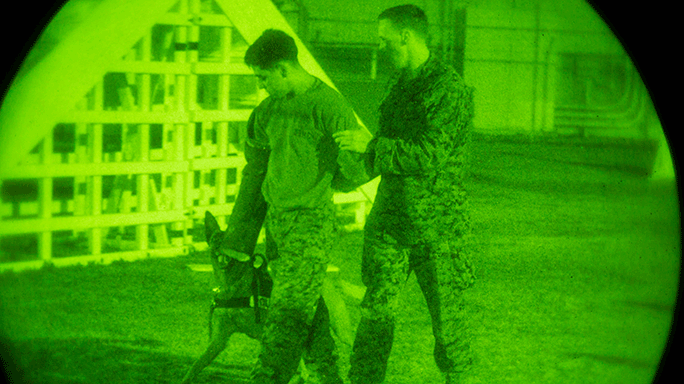The following is a release from Lance Cpl. Aaron Henson, Marine Corps Air Station Iwakuni, Japan:
MARINE CORPS AIR STATION IWAKUNI, Japan — Military working dogs are trained in multiple abilities such as locating narcotics or explosives and conducting patrol work. The K-9s are also trained in the five phases of aggression, basic obedience and building searches which aid in a variety of potentially dangerous situations.
- RELATED STORY: Marine Dog Teams Get Realistic Training at Camp Pendleton
“The K-9’s are trained with multiple specialties and they all have different capabilities,” said Cpl. Brendon Teague, military working dog handler with Headquarters and Headquarters Squadron. “They have the ability to search through buildings, find drugs, explosives and attack a fleeing suspect.”
Advertisement — Continue Reading Below
To ensure the safety of personnel on the air station, the K-9 training is conducted to keep military working dogs familiarized with the installation as its landscape continues to develop with the Defense Policy Review Initiative.
“This benefits the air station and the general populous by allowing us to conduct more advanced training than we would be able to during the day while everyone is working,” said Lance Cpl. Landon Gilliam, military working dog handler with H&HS. “Night training gives us different scenarios in which the (military police), K-9 unit and everyone else can operate together just in case such events were to happen.”
Handlers and their dogs must train regularly in order to maintain combat readiness, become a more effective team and ensure the safety of everyone on the air station.
Advertisement — Continue Reading Below
“We conduct night training once a month to stay familiar with the installation,” said Sgt. Adrian Nanez, kennel master with H&HS. “Training at night provides us with the capability to utilize buildings that we would not be able to use during the day. … The mission of PMO is to protect every person on this installation so the base can keep functioning.”
The location and types of training are changed each time to broaden the capabilities of the K-9s, as well as the handlers.
“We are able to go in, get our dogs familiarized and leave knowing that our dogs and handlers progressed to a new level as a team,” said Teague.
Advertisement — Continue Reading Below
























